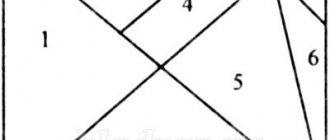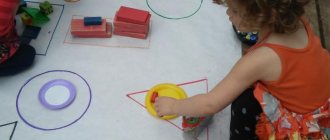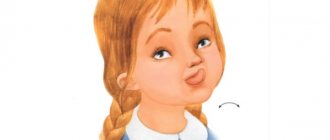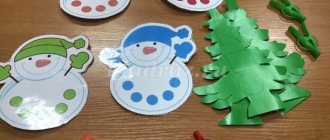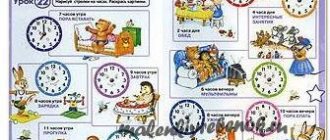Formation of ideas about time in children in the older group
Formation of ideas about time in children in the older group
- Peculiarities of perception of temporal concepts by children of the older group.
- Contents of the preschool education curriculum of the educational field “Elementary mathematical concepts”, component “Time” in the senior group. (working with the program)
- Methods for developing children's ideas about the concepts of “year”, “season”, “month”, “week”, “day”, quantitative characteristics and the relationships between them.
- Using models in the process of familiarizing with time periods.
- Introducing children to the calendar.
- Peculiarities of perception of temporal concepts by children of the older group.
Perception of time
– reflection in a person’s consciousness of the duration, sequence, speed and frequency of processes, phenomena, actions.
At older preschool age, children actively reflect time categories in speech, however, they are less able to assimilate time terms expressing the duration and sequence of events. They perceive time from the activities of other people, from objective natural phenomena.
Reasons for difficulty perceiving time:
1. irreversibility of time: it is impossible to return the past;
2. fluidity of time;
3. lack of visual forms of time.
- Methods for developing children's ideas about the concepts of “year”, “season”, “month”, “week”, “day”, quantitative characteristics and the relationships between them.
In the older group
work begins with clarifying the ideas and skills that were formed in the previous group (about the parts of the day and their changes, about the concepts of today, tomorrow, yesterday, about the seasons).
In older preschool age, children develop the ability to determine quantitative relationships between time periods
: days of the week and week (1 week - 7 days), weeks and month (4-5 weeks - 1 month), months and seasons (3 months - 1 season), seasons, months and years (12 months - year )
Methodology for forming ideas about the day
Ideas about the concept of “day” are being improved. In the older group, children develop the ability to determine the periods of the day, observing not only the work of people, but also the position of the sun. Through observations and comparisons, the concepts of “vault of heaven,” “sunset,” and “horizon” are explained to children, and they are given the opportunity to make sure that the position of the sun in the sky in the morning and evening is different, that the sun moves across the sky throughout the day. During the day, compared to morning and evening, the sun rises above the horizon, and shadows from objects become short. The period of the day when the sun is high in the sky and children are playing in the garden is called “noon”, this is the middle of the day. Based on direct observations and examination of corresponding reproductions of paintings, children of this age group are introduced to the phenomena: “sunset”, “sunrise”, “twilight”, “dawn” and explain why they say about these periods of the day: “dusk”, “dawn” "
To form ideas about the change of day, conversations are used and questions are asked:
- What did you do yesterday (today, tomorrow)? (in response - characteristic actions).
- When did you go to the park (do the actions mentioned)? (in response - yesterday, or today, or tomorrow).
After the children have well mastered the sequence of days of the week, a conversation is held every day: what day of the week is today, what was it yesterday, what will it be tomorrow.
As in the middle group, the “3-day” method is used.
Exercises are carried out on the rotation of 3 days: children are given 3 sets of cards for the parts of the day and are asked to arrange these cards to make three days. It is explained: as soon as the night of the 1st day ends, the morning of the second day begins, those days that have passed are called “yesterday”, and those days that are coming are called “today”. After the night of today, a day comes, which is called “tomorrow”.
Exercises with three pictures, one of which depicts an event. The card with the event is placed in a certain place (“today” - in the middle, “tomorrow” - on the right, “yesterday” - on the left) and it is found out “When does this happen?” or the task is given “Place the card so that the event occurs “tomorrow”.
You can consolidate ideas about the present, past, and future tenses in the process of reading literary works (“The Tale of Yesterday” by E.Ya. Ilyin, “A Good Day” by S.Ya. Marshak), conducting didactic games “It was and will be,” “When was that?”, “Complete the sentence”, “Yesterday – today”, etc.
Formation of ideas about the days of the week and their sequence in children in the older group
Children, when they have mastered counting within seven, are introduced to the fact that days have their own names, that seven days, or days, make up a week, and the sequence of every seven days is the same: Monday, Tuesday, Wednesday, etc.
Forming ideas about the sequence of days of the week, they draw children’s attention to the alternation of work and rest: five days are working days, and two are days off, clarify the name of each day of the week, their sequence, linking them with the children’s activities, ordinal counting. For example, Monday is the first day of the week, the first day after rest, on Monday you and I go to the pool; Tuesday is the second day of the week, on Tuesday we have a math lesson, etc.
When getting to know the days of the week, various calendars and models are used.
When getting acquainted with the week, you can use numbers, number cards, colored circles, geometric shapes, with the help of which children perform exercises on composing one or two weeks, starting from any day.
To consolidate knowledge about the sequence of days of the week, didactic games “Week”, “Whose week will come together faster”, “Living Days”, “Who knows, let him name”, “Name the neighbors”, etc. are used.
In the older group, children determine the current day every day, name the past and the future. Mastering the idea of changing the days of the week, and then the change of one week to another, brings children to the idea of the periodicity of time. Children begin to understand that there was a Monday in the week, it has passed, and in seven days it will be Monday again.
Formation of ideas about the months of the year and their sequence in children in the older group
Throughout preschool age, work is underway to familiarize children with the seasons
. At the initial stages, the formation of ideas about winter, summer, spring, and autumn is based on the most striking, characteristic manifestations of the seasons. From individual signs, a general picture of the season gradually emerges: weather, air temperature, day length, condition of animals, plants, characteristic types of human activities in nature, seasonal changes in clothing, holidays and entertainment, etc.
When working with older children, works of artists and reproductions of paintings are used: “Golden Autumn” by I. Ostroukhov, “Autumn in the Park” by N. Dubrovsky, “Winter Day”, “Summer”, “May”, T Yablonskaya, “Vyasnovy Kraivid” A. Astapovich, The mornings are clear” In Kudravich “The Black Drop” - V. Byalynitskaga-Biruli, “The Black Day” by V. Tsvirki, “Leaves” I. Shchamyalev, works by I. Levitan, N. Roerich and others.
In the process of becoming familiar with the seasons, children are given the idea that each season does not pass at once, but lasts for a certain, approximately equal time, and includes three months. Reading poems and fairy tales helps children remember the sequence of months; conversations based on what they read help them establish the relationship between time standards: year, month, season, week, day.
The children themselves begin to say that “the year turns”: summer was, it passed, and summer comes again.
Reading works of fiction. Fairy tale “12 months”, poems, cartoons that talk about the sequence of time units.
An illustrated calendar of the year should always hang in the group. Children are taught to remember the sequence of months in each season. Children remember the names of the months in Russian more difficult, but the Belarusian names of the months are easier, because they are associated with specific natural phenomena and human activities.
Games:
- "Continue". The presenter names the time unit, and the children name the next or previous one. Options: with a ball, without a leader (the ball is passed in a circle), children stand in a line - who can reach the leader faster.
- “Name the neighbors” (with a ball, with cards, with a circular model) - the leader names the time unit, and the children name the previous and subsequent time units.
In order for children to unobtrusively remember the sequence of time units, constant visualization should be used in the group.
Methodology for introducing the general concepts of “day”, “week”, “year”
(using the example of a day)
To introduce the generalizing word “day”, a didactic game “Name it in one word” is played. First, it is proposed to generalize other concepts familiar to children (furniture, dishes). Then a card is given that shows the characteristic features of the four parts of the day (morning, afternoon, evening, night).
Questions: What time of day is shown in the 1st (2nd, 3rd, 4th) picture? How can you name all 4 pictures in one word?
Conclusion: when morning, afternoon, evening, night pass, we say that a whole day has passed.
In the future, it is necessary to show the children that a day consists of 4 parts, following each other in a certain sequence. At first they say that the day begins in the morning (the week begins on Monday, the year begins in spring). And then they explain that a day (week, year) can begin with any part of it (For example, if a week starts on Monday, it ends on Sunday, and if it starts on Thursday, it ends on Wednesday). For example, we will finish reading a fairy tale in a day. (Do I have to wait until morning to count down the day?).
Games:
- "Continue". The presenter names the time unit, and the one to whom the ball was thrown must name all the other parts in order to form a whole (day, week, year).
— “Build for a day,” “Week,” “Build for a year.”
Options:
1) arrange the pictures so that you get a day (week, year),
2) it is necessary to build in the order of time units (children play the role of parts of the day (days of the week, seasons)). Children must make a verbal countdown: “I am Wednesday, I stand behind Tuesday, before Thursday.”
- Using models in the process of becoming familiar with time periods
The purpose of using time interval models
- introduce children to the continuity and fluidity of time.
The model and calendar are a unique way of “materializing time”, reflecting it in a visual, conditionally schematic form. They help children more easily master the sequence of parts of the day, week, year, and better understand the relationship between time categories. Acting with the model, the child solves cognitive problems and reflects his ideas about time in speech.
Types of Time Frame Models
- Planar models
Planar model of the week
Option 1 - leaves of different colors with numbers from 1 to 7; they can also depict the activities inherent in this day of the week. Children are shown the connection between the names of the days of the week and ordinal numbers (1st Monday, 2nd Tuesday, etc.).
Option 2 R. Chudnova suggests using a large circle (35 cm in diameter) as a demonstration material, on which multi-colored circles (8 cm in diameter) are arranged in order, and on them are small white circles numbered from 1 to 7, corresponding to the ordinal numbers of the days of the week. Multi-colored circles are placed as follows: black, gray, blue, green, yellow, pink, red. In the middle of the large circle there is a moving arrow, with which you can show today, determine what day of the week it was yesterday, what day it will be tomorrow, and how many days are left until the weekend.
Planar (circular) model of the year
.
The symbol of the year can be a circle divided into 4 equal parts and painted in certain colors: the white part means winter (everything is covered with white snow in winter), the red part means summer (the red sun shines brightly in summer), the green part of the circle means spring (green grass appears in spring). , green leaves bloom on the trees), autumn – yellow (in autumn the leaves turn yellow).
Each of the 4 parts of the circle is divided into 3 parts (according to the number of months in the season). An arrow is placed in the center. This manual can be used in different ways: the teacher shows the season with an arrow, and the children name it, establish “neighbors”, change the months included in this season, etc.
- Volumetric models
Models of the day
To make it, you need to take 4-5 flat circular models of the day of the same diameter from cardboard or thick paper. The circles are divided into four equal sectors, painted in different colors (yellow - “morning”, red - “day”, blue - “evening”, black - “night”). Three of them are cut along the radius separating “morning” from “night”. For ease of manufacture, a circle of small diameter is cut out in the center.
We number the marked radii and edges of the cuts: 1,2,3,4,5,6,7,8, and then connect edge 2 with radius 1, edge 3 with edge 4, edge 5 with edge 6, edge 7 with radius 8. For connection, you can use colorless adhesive tape. A similar principle of constructive activity from paper of the “garland” type (described by 3. Lishtvan). You can connect the circles together with your children, then they will understand more clearly the process of changing one day to another and the time intervals “yesterday”, “today”, “tomorrow”.
To make the model convenient to use, you can fasten the upper and lower bases with a metal rod or, by making the lower base more massive, hang the model like a flashlight.
The proposed model creates a visual image of the “transition” of the night of yesterday into the morning of today, and the night of the current day into the morning of tomorrow.
The model can be included in the didactic game “Time Travel”:
Goal: to consolidate in children the concept of “day”, “part of the day”, “yesterday”, “today”, “tomorrow”, ideas about the alternation of the day and parts of the day.
Didactic material: three-dimensional model of the day, a small “Dunno” doll.
Recommendations for implementation: it is advisable to conduct the game with a group of children of senior preschool age after familiarizing themselves with the three-dimensional model of the day and its production.
In a similar way, you can make three-dimensional models of the week and year, taking flat circular models of the week and year as a basis.
Models of the week
When making three-dimensional
models of the week,
each circle is divided into seven equal parts, painted in different colors of the spectrum, pasting a certain number of small white circles in the sector (from 1 to 7), taking into account children’s knowledge of the connection between the names of the days of the week and ordinal counting: Monday is the first day of the week, Tuesday is the second, etc. The cut is made along the radius separating “Sunday” from “Monday”. The rest of the production is similar to the described model of the day. Using this model, you can illustrate the fluidity and alternation of time intervals, show that after one week another begins, followed by the next, etc. The flat circular model does not provide such an opportunity; the child gets the impression that Monday coming after Sunday is the same as it was at the beginning of last week.
Models of the year
Performing a volumetric (spiral) model of the year
, the circles are divided into 12 equal parts, and when painting the seasons of the year, they take the main colors and their shades, for example: autumn - shades of yellow (September - light yellow, October - yellow, November - orange), winter - shades of blue, spring - green, summer - red. A cut on the circle is made along the radius separating “December” from “January”. This model of the year allows us not only to form ideas about the months of the year and the year, but also about the succession of one year to another. When conducting the didactic game “Time Travel,” you can similarly show that the game character becomes a year older.
Montessori time model.
It is a circle (cardboard or wire) with ribbons along the border (365 ribbons), after 7 days the ribbons are woven into a braid; after 1 month - in a bun; every other season - in a bundle of the same color for one season.
Such models have their advantages in use: they reflect the dynamic change of time cycles; multifunctional in work, since with their help it is possible to consolidate not only the concepts of time standards, but also to illustrate the properties of time (fluidity, turnover); They are quite simple to manufacture and are more understandable to preschool children, because the components used are flat models in the form of circles familiar to children.
- Introducing children to the calendar.
In order for this complex system of interconnected units of time to be understood by children, it is presented in the form of a calendar, reflecting in material form the relationships between units of time. A calendar (tear-off, wall, flip, etc.) helps children imagine relatively long periods of time.
At one time, F.N. Blecher wrote that the tear-off calendar provides a visual representation of the fact that “the days are passing” and events are approaching; A month has passed and a new one has arrived.
Tear-off calendar materials:
Calendar sheets measuring 9X6 cm must be secured so that they can be easily removed from the rods. On the front side of each sheet contains a number (number), the name of the day of the week and month. But since not all children in the older group can read, there should be a strip of the corresponding color on the bottom sheet, by which children can identify (“read”) each day of the week on the calendar. The reverse side of the sheet remains blank.
For removable calendar sheets, a box is made with 18 compartments according to the size of the sheets (three rows of six cells). In the cells of the lower compartment, sheets of paper are placed sequentially - days of the week, seven sheets of paper in each cell. Seven sheets of paper—seven days in each cell—should give children an image of the past week. At the end of the month, the number of weeks and days is calculated. The leaves collected during the month are placed in a stack in the first cell on the left of the top row. So, six cells of the top row of the box will gradually be filled, and then six cells of the second row. Thus, the stacks in the top two rows of the box show the order of months, and the bottom row shows the order of days and weeks. At the end of the year, the number of months in the year is counted, determining the order in which they appear.
Such a manual serves as a model of the calendar year, since with its help the interrelation of all measures of calendar time is clearly reflected. Children themselves take off the sheets of the calendar and add a week from a day, a month from weeks, then determine the place of this month among others. The months gradually and sequentially form a year. By the contents of the box and by the calendar sheets laid out in it, you can determine how many days have passed since the beginning of the month, how many months have passed since the beginning of the year, and by the empty cells - how much is left until its end. By performing all these actions, children gradually comprehend and realize the complex quantitative relationships between individual measures of time.
It is necessary to conduct four organized classes for children of older groups (6th year of life, 7th year of life), which provide the necessary knowledge about time standards associated with calendar time. The assimilation and further consolidation of acquired knowledge should occur in everyday life and active independent activity with the calendar model.
1 lesson in January. Conversation about the beginning of the year, months, days of the week, showing ways to use the calendar
Lesson 2 - a week after the first, a second lesson was held, during which ideas about the days of the week were clarified and the ability to associate the names of days in the week with ordinal place was formed. In this lesson, children seem to see the whole week, presented in the form of seven calendar sheets laid out sequentially on the board.
Lesson 3 - in early February, ideas about the week, the names of the days of the week, and their sequence were clarified.
Every day children work with the calendar, name the month, date, day.
At the end of each month, the children have a short conversation about which month ended, how many weeks and days it had, all this is compared with the previous month. The number of months that have passed since the beginning of the year is determined and the name and serial number of the new month are specified.
In the older group (6-7 years old), children continue to work with the same calendar; on the first days of the new year, the last general lesson on the calendar was held. In this lesson, ideas about the calendar year are clarified (how many months there are in a year, which ones). A visual material for the lesson is a box with calendar sheets for the past year arranged in it by month. The questions were the same as in the first lesson. “What holiday did we all celebrate the other day? What year did it end? What year is it? When did the new year start? (What month? What date?) How many months were there last year? What is the first month of the year? Etc.
LITERATURE
- Budko, T.S. Theory and methodology for the formation of elementary mathematical concepts in preschoolers: lecture notes / Pod. ed. Budko T.S.; Brest State University named after. A.S. Pushkin. – Brest: BrGU Publishing House, 2006.
- Leushina, A.M. Formation of elementary mathematical concepts in preschool children. age. – M., Education 1974
- Richterman, T.D. Formation of ideas about time in preschool children. – M., Education 1982
- Formation of elementary mathematical concepts in preschoolers / ed. A.A.Stolyar. – M., Education 1988
- Shcherbakova, E.I. Methods of teaching mathematics in kindergarten: a textbook for preschool students. department and faculty avg. ped. textbook establishments. - M., Ed. , 1998
5
Advice to EVERYONE for the future - “they said” and “answered” does not oblige anyone to anything.
Therefore, if you want to know the legality of the attitude towards you on any vital issue, then contact in writing, go to a personal meeting with the head of your problematic area (issue) and demand a written answer, from which it will be clear, for example, what “requests of kindergarten managers” were The start date of the school year has been changed, since almost everything in a preschool educational institution depends on this date - educational programs, financing, and planning of educational activities for the municipality, region and the whole country.
I doubt that the requests of the heads of preschool educational institutions can influence this.
